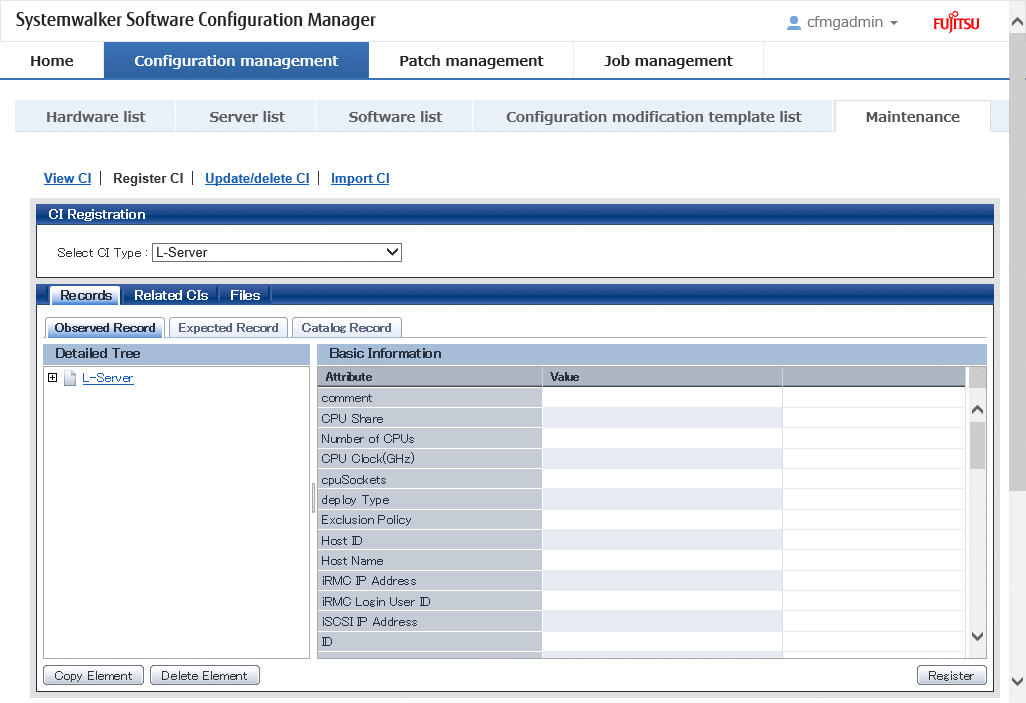Display method
Click the Maintenance tab in the Configuration management window.
Select the Register CI link.

Operation method
Item | Description | ||
|---|---|---|---|
Register CI | Select CI Type | Pull-down list box used to select the CI type of the configuration items to be registered. | |
Records tab (Displays expected, observed and catalog information) | Detailed Tree | A tree of elements that make up the configuration item. When an element is selected, the attribute values for the element are displayed in the Basic Information section. | |
Basic Information | Attribute | Displays the names of the attributes. The list can be sorted by attribute names by clicking the Attribute column header. Values must be entered for the following attributes of each CI type:
The value of the id attribute must be unique within each CI type. If a configuration item has been registered by specifying an existing value for the id attribute, the existing configuration item will be updated by overwriting it. For the following CI types, in addition to the above attributes, values must be entered for the attributes below.
| |
Value | Displays the values of the attributes. The value of an attribute can be edited by selecting the Value column corresponding to the attribute and then either clicking the column or pressing the Enter key. The list can be sorted by attribute values by clicking the Value column header. | ||
Copy Element button | Creates a duplicate of the element selected in the Detailed Tree. | ||
Delete Element button | Deletes the element selected in the Detailed Tree. | ||
Related CIs tab (Displays a list of the configuration items that are related to the configuration item for which the details are being displayed.) | GID | Displays the GIDs of the configuration items. The list can be sorted by GIDs by clicking the GID column header. | |
CI Type | Displays the types of the configuration items. The list can be sorted by CI types by clicking the CI Type column header. | ||
Nickname | Displays the nicknames of the configuration items. The list can be sorted by nicknames by clicking the Nickname column header. | ||
Records | Displays the records held by the configuration items. It displays "O" (observed record), "E" (expected record), or "C" (catalog). | ||
Direction | Displays the direction of the relation for the configuration items related to the selected configuration item. The list can be sorted by the direction of the relation by clicking the Direction column header. | ||
Add button | Associates the configuration item being edited with another configuration item. | ||
Remove button | Deletes the relationship with the configuration item selected in the list of related configuration items. | ||
Files tab (Displays a list of the files held by the configuration item for which the details are being displayed.) | File Name | Displays the names of the files. The list can be sorted by file names by clicking the File Name column header. | |
Nickname | Displays the nicknames of the files. The list can be sorted by nicknames by clicking the Nickname column header. | ||
Annotation | Displays the annotations for the files. The list can be sorted by annotations by clicking the Annotation column header. | ||
File Size | Displays the size of each file. The list can be sorted by file size by clicking the File Size column header. | ||
Last Updated | Displays the date and time when the file was last updated. The list can be sorted by last update date/time by clicking the Last Updated column header. | ||
File ID | Displays the IDs of the files. The list can be sorted by file IDs by clicking the File ID column header. | ||
Version | Displays the version names of the files. The list can be sorted by version names by clicking the Version column header. | ||
Hash value | Displays the hash values for the files. The list can be sorted by hash values by clicking the Hash value column header. | ||
Add button | Adds a file to the configuration item. | ||
Remove button | Deletes a file that has been registered with the configuration item. | ||
Register button | Registers the settings with the CMDB. | ||